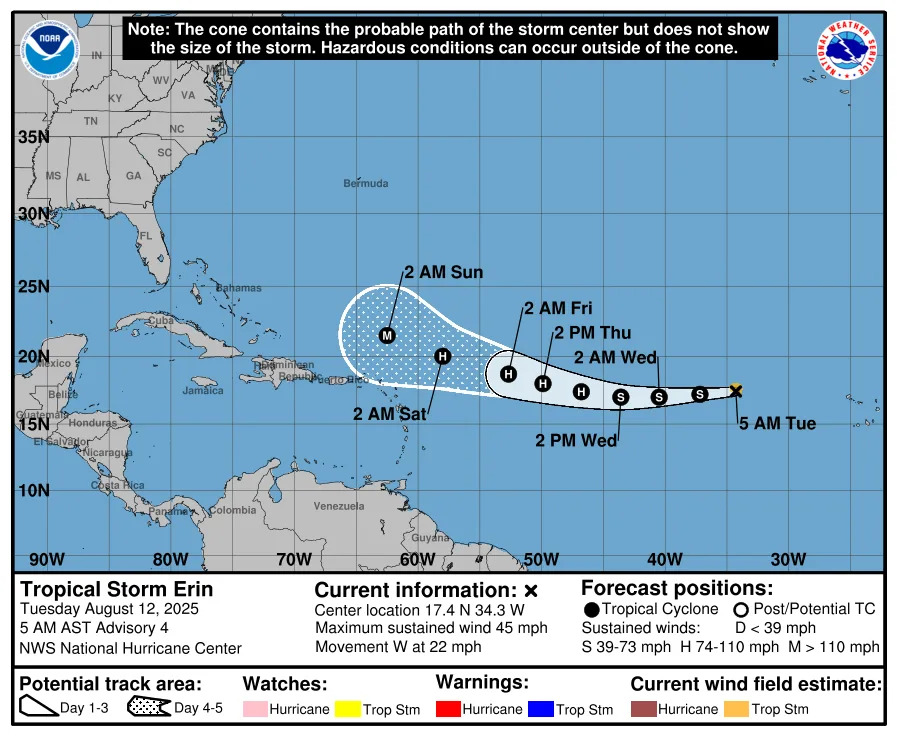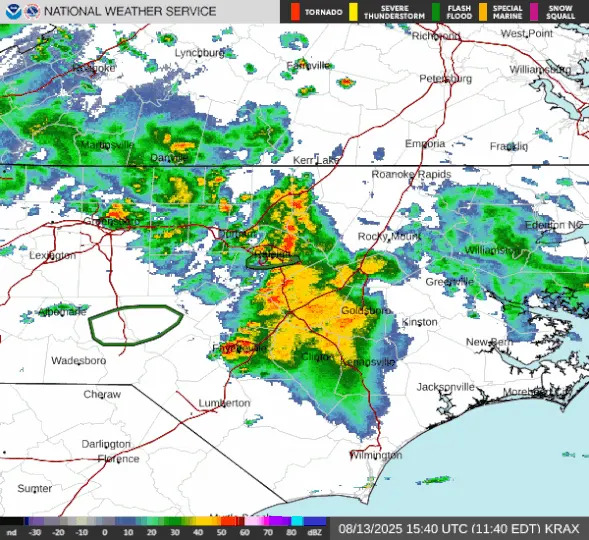The National Hurricane Center is tracking three systems in the Atlantic basin, including a new homegrown system that appeared near the Yucatan Peninsula late Aug. 12.
Tropical Storm Erin in the central Atlantic is expected to begin strengthening Wednesday, Aug. 13. It's forecast to become a hurricane by Thursday or Friday and a major hurricane Sunday, Aug. 17. A major hurricane is a Category 3 or stronger storm with maximum sustained winds of at least 111 mph.
➤ Weather alerts via text: Sign up to get updates about current storms and weather events by location
Will Tropical Storm Erin impact North Carolina?
Special note on the NHC cone: The forecast track shows the most likely path of the center of the storm. It does not illustrate the full width of the storm or its impacts, and the center of the storm is likely to travel outside the cone up to 33% of the time.

It's too early at this time to determine whether Erin will have any impacts on North Carolina or reach the United States at all.
"There is even greater uncertainty in what impacts might occur in portions of the Greater Antilles, the Bahamas, the east coast of the United States, and Bermuda next week," the National Hurricane Center said.
Erin could bring an increase in rough surf and rip currents to the east coast next weekend and into early next week, even if it curves north, staying away from the U.S., according to AccuWeather.
Here's the latest update on Tropical Storm Erin.
Location: 1,400 miles east of the northern Leeward Islands
Maximum sustained winds: 45 mph
Movement: west at 20 mph
Pressure: 1,004 mb
Where is Tropical Storm Erin headed? See projected path
Tropical Storm Erin spaghetti models
Special note about spaghetti models: Illustrations include an array of forecast tools and models, and not all are created equal. The hurricane center uses only the top four or five highest performing models to help make its forecasts.
Will the new disturbance moving into the Gulf impact North Carolina?
The system currently has a low chance of developing as it enters the southwestern Gulf on Aug. 14, according to the National Hurricane Center.
While North Carolina is typically affected by named storms originating from the Gulf, this disturbance is expected to move in the opposite direction — northwest from the Yucatán Peninsula — and is unlikely to impact the state.
How does the 2025 Atlantic hurricane season compared to last year in North Carolina?
While the 2025 season may feel slow compared with 2024 — when Hurricane Beryl became the earliest Category 5 storms on record before making its final landfall in Matagorda, Texas — Erin is actually right on schedule when it comes to hurricane status.
The first hurricane usually develops around Aug. 11, the first major hurricane around Sept. 1, and the fifth named storm around Aug. 22, according to AccuWeather.
The storm’s approach comes as forecasters say hurricane season is entering its most active stretch. Colorado State University meteorologists are holding to their July outlook for a slightly above-average season: 16 named storms, including eight hurricanes, three of them major. Four storms have already formed, compared with an average of 14 named storms and seven hurricanes.
For North Carolina, the season has been quiet so far, following a similar pattern to 2024.
Around this time last year, Tropical Storm Debby brought heavy rain, flash flooding, tropical storm–force wind gusts, minor coastal flooding and three weak tornadoes to southeastern North Carolina after making landfall in Florida's Big Bend region on Aug. 5, 2024, and then a second landfall in South Carolina's Bulls Bay between Charleston and Georgetown early on Aug. 8, 2024.
By late September, the state tracked Tropical Storm Helene, which caused flash floods, landslides and hundreds of fatalities fatalities after moving through the Appalachians.
So far, no storms have directly affected the state, but Colorado State researchers say North Carolina has one of the highest odds of seeing impacts from a hurricane or named storm this season — second only to Florida.
When is the Atlantic hurricane season?
The Atlantic hurricane season runs from June 1 through Nov. 30.
Ninety-seven percent of tropical cyclone activity occurs during this time period, NOAA said. The season peaks in August and September.
The Atlantic basin includes the northern Atlantic Ocean, Caribbean Sea and Gulf of America, as the Gulf of Mexico is now known in the U.S. per an order from President Trump. NOAA and the National Hurricane Center are now using Gulf of America on its maps and in its advisories.
North Carolina weather radar

North Carolina weather watches and warnings
Stay informed. Get weather alerts via text
Brandi D. Addison covers weather across the United States as the Weather Connect Reporter for the USA TODAY Network. She can be reached at [email protected].
This article originally appeared on Asheville Citizen Times: New system in Gulf as Tropical Storm Erin moves in. Will they hit NC?




Comments